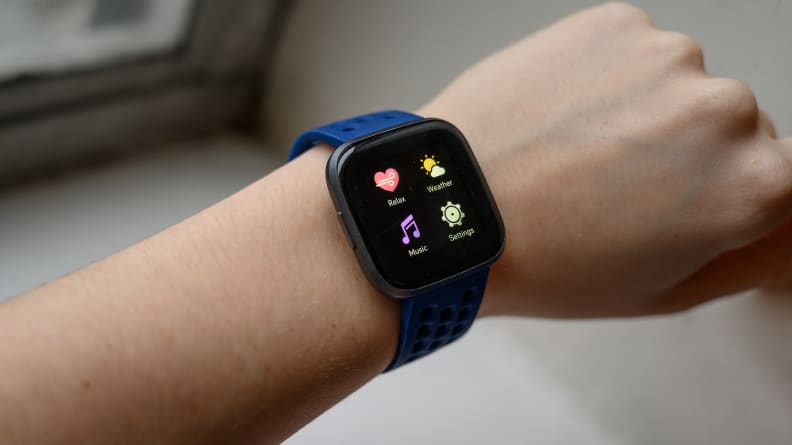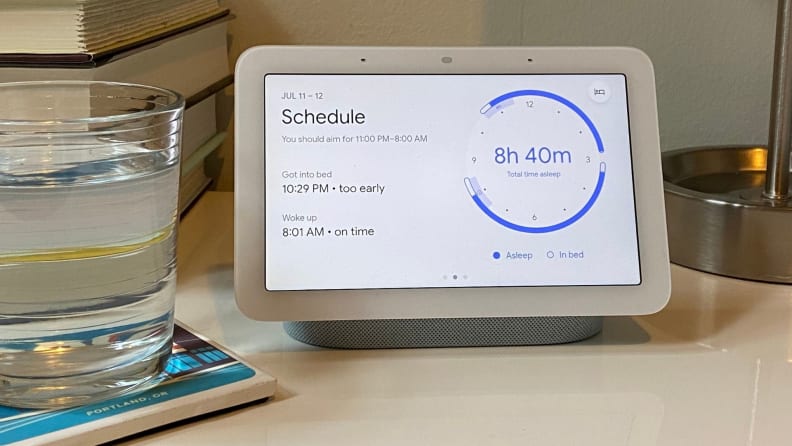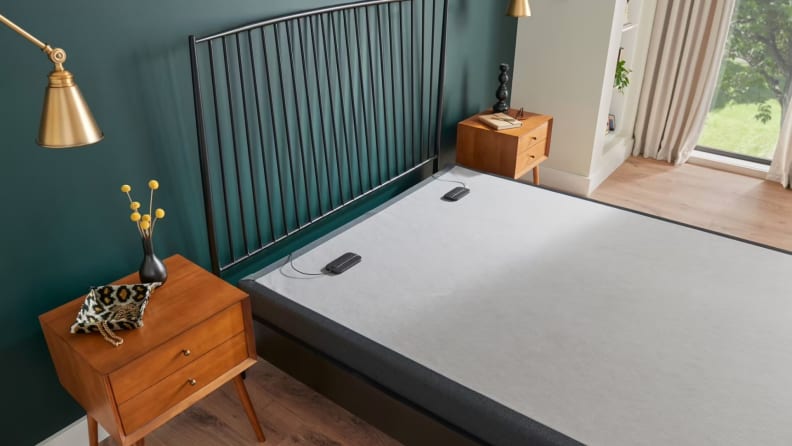Products are chosen independently by our editors. Purchases made through our links may earn us a commission.
Data is abundant with the rise of smartphones and other technologies at our fingertips. It even extends beyond our waking hours with sleep trackers that can offer overnight heart rate, blood oxygenation, and restlessness metrics. While we still don’t understand everything sleep does for our bodies—or why we dream, for example—nowadays we can use fitness trackers to follow, and maybe even improve our nightly sleep.
If you've spent a long time wondering how these devices work, we're here to help. Here's everything you need to know about sleep trackers.
What do sleep trackers measure?
Movement
Most entry-level sleep trackers only track movement to determine if the user is asleep. Of course, anyone who has laid awake at night knows that movement is not the most necessary and reliable factor for determining sleep.
Sleep Trackers use accelerometers, which measure acceleration. For instance, Fitbit and Garmin, and Whoop use “three axis accelerometers” to measure movement along three planes. One is parallel to the device’s screen and runs left to right, another parallel plane runs from the top to bottom, and the third is perpendicular to the device’s screen and points upward. Apple Watch also relies on at least one accelerometer, though I couldn’t find specifics on the configuration of axes. Even the most scaled-back Fitbits, like the Fitbit Flex—an early model that was discontinued—rely upon three-axis accelerometers to follow movement as you sleep.
Heart Rate and Respiration
Wearables with heart rate detection can provide a more nuanced snapshot of your sleep, including the different stages of your sleep cycle. According to Fitbit, its devices with heart rate monitors rely upon “a combination of your movement and heart-rate patterns. When you haven’t moved for about an hour, [the] tracker or watch assumes you’re asleep. Additional data—such as the length of time your movements indicate sleep behavior [like] rolling over… help confirm that you’re asleep.”
But the ever-present question is how? If you own a wearable, you’ve probably noticed the little lights on the back of the device. Turns out those are the key. On Fitbits, for example, these tiny LEDs monitor heart rates by “flash[ing] hundreds of times per second.” After each flash, the device uses a diode to translate brightness into data. With every heart beat, blood surges through your veins. Pulses reflect less green light, whereas a greater amount reflects in between each beat, allowing the diode to determine how often your heart beats.
Of course, if you’ve ever used one of these devices, you may know these LEDs work constantly—including overnight when there are significant changes to your pulse. It decreases early in the night as your body shuts down. In deep sleep, your heart rate will drop to 20% or 30% below your resting rate. As such, wearables with heart rate tools can provide a more accurate picture of not only the stages of sleep, but when you fall asleep to begin with.
Sound
While less common, some sleep trackers measure environmental factors like sounds to determine if the user is asleep. In addition to picking up the sounds of movement associated with alertness, trackers will use microphones to pick up the sound of snoring and signs of sleep apnea.
Types of sleep trackers
Wearable devices

Most wearables use a combination of movement and heart rate to assess your sleep.
Wearable devices with sleep tracking run the gamut from the classic Apple Watch and Fitbit offerings to off-the-beaten-path products such as the Oura Ring. Most rely heavily on heart rate and movement to estimate sleep stage and overall quality.
Certain devices, including Garmin watches with advanced sleep monitoring as well as some Fitbits, may use pulse oximetry to track the oxygen saturation in your blood. This feature utilizes a combination of red and infrared sensors (a.k.a. the red light on the back of your device). The two types respond differently to blood that’s more or less oxygenated. Highly oxygenated blood absorbs more infrared light and allows a lesser proportion of red light to reflect back.
Though none of the sleep trackers we’ve tested or discuss in this article are medical grade, pulse oximetry is a tool used by professionals to assess hypoxemia, or an abnormally low concentration of oxygen in the blood. When present overnight, it’s a hallmark of sleep apnea. Wearables with this feature may send the data to your phone, which you can review for yourself for any noticeable patterns. For instance, if the app shows your levels are a little low, you can mention it to your primary care provider or another medical professional to see if it’s of concern.
Despite all the technology, these devices aren’t perfectly accurate and have a limited battery life. You’ll have to remember to recharge if you never want to go a night without sleep data. Even so, the data they collect and transmit to your phone (usually accessible via the manufacturer's app) may not tell you everything. I’ve used the Fitbit Sense, and own a Versa, and they both consistently failed to decipher exactly when I’m asleep, as opposed to when I’m in bed, but on my phone and barely moving. What’s more, sometimes the overall sleep scores don’t line up with my subjective experience. I may think I slept great, but according to Fitbit, my rest wasn’t, er, restful at all.
Bedside devices

The Nest Hub is the only sleep tracking device that's detected exactly when I go to bed and fall asleep.
I’ve tried most types of sleep trackers, aside from a full-on smart mattress. They all left something to be desired, but that wasn’t true of the Google Nest Hub, a smart display with sleep tracking.
The Google Nest Hub is unlike many other sleep trackers in that it doesn’t come into physical contact with you or your mattress. It simply sits on your nightstand. (This also is a plus in that it doesn’t require charging; it’s simply plugged in all the time.)
The Nest Hub passively tracks sleep using an old technology that Google made new again: radar. According to the tech company, the Nest Hub uses Soli miniature radar to measure sleep. This is paired with a microphone, and the data gathered from both is analyzed in-house—meaning it’s not transmitted or stored in the cloud.
It works with astounding accuracy and isn’t as invasive as wearables. (Though, if you’re particularly privacy conscious, remembering to turn the microphone off and on could be a nuisance.)
Non-wearable tracking pads and sensors

Sleep trackers like Tempur-Pedic's are placed under the mattress.
Non-wearable devices have a few distinct benefits. These systems add one or multiple sensors to the surface you’re sleeping on, and like the Google Nest, don’t require you to charge or touch them.
Pads that sit on top of a mattress include Eight Sleep’s The Pod Pro Cover. It transforms a traditional mattress into a smart version by adding a fabric cover that integrates tracking for heart rate, respiratory rate, and more. It supports two sleepers, meaning you can also track a partner’s sleep. And like wearables, the cover relies on heart rate measurements, plus a couple others variables like respiration. Unfortunately, an Eight Sleep customer service rep wasn’t able to provide details on how exactly its technology works.
I personally tried a lower-tech (and lower-price) Sleeptracker from Tempur-Pedic. For $299, this tracker relies on two thin foam sensors placed beneath the mattress, under the area where your pillow rests. It also includes a processor that’s about the size of a bar of soap and just kind of floats around nearby. It’s compatible with a variety of mattresses and bases, making it easy to integrate with your current set-up, whatever that may be.
As with Eight Sleep, Tempur-Pedic won’t provide much information on how its sensors work, and what exactly they use to track sleep. According to a customer service rep, the tracker “detects the micro-motion generated from your heartbeat and respiration cycles. The sensors rely on measuring vibrations to calculate."
Despite the company’s claims, I found the sensors weren’t all that accurate. Based on the information I was given via the company's corresponding smartphone app, the sensors failed to detect when I was actually asleep, as opposed to when I was motionless in bed scrolling through TikTok videos.
Smart mattresses and bed sensors
Why buy a mattress pad when you can be “smart” from the get-go? There are a few smart mattresses available that have built-in technology to track your sleep.
Eight Sleep is one of the more prominent companies in this domain, too. Its (admittedly costly) mattress, called the Pod Pro, retails for more than $3,000. It captures metrics such as sleep stages, sleep time, and tossing and turning—and it features its own water-based, fully integrated cooling system. I ran into the same issue getting details on this mattress as I did with its cover: Customer service refused to elaborate on the technology, though the product description mentions it looks at respiratory rate, resting heart rate, and heart rate variability.
Eight Sleep’s data processing also raises more privacy concerns than some of the other trackers featured in this article. According to a representative, the product is managed via Wi-Fi and app connection, and transmits data on your sleep to a warehouse for analysis.
Smartphone apps
Smartphones don’t have the advanced radar and pulse oximetry measurements like other types of sleep trackers. Instead, phone-based sleep tracking goes back to one or two of the most basic elements: movement and/or sound.
Sleep Cycle is one such popular app. It has more than 300,000 ratings and 4.7 stars on the Apple App Store. It relies purely on a microphone's audio to determine which sleep stage you’re in—I'm dubious about just how accurate it is. Other apps use the phone's built-in accelerometer to detect movement throughout the night and make conclusions about your sleep quality and cycles from there.
There are plenty of apps out there that purport to track your sleep. And while they’re probably better than nothing, I’m skeptical given the inaccuracies I’ve seen in wearables and other sleep monitoring devices.
How to determine whether you should use a sleep tracker
Sleep tracking devices come with some benefits, but there are a handful of drawbacks, too. Experts generally don’t recommend relying too heavily on sleep trackers, as they’re just one part of a far bigger picture.
I can also speak from personal experience: These devices aren’t always accurate. It’s hard for most sleep tracking devices to determine when I’m actually asleep, as opposed to lying motionless in bed and on my phone. That’s because so much of the data and information they gather is based on movement.
Some swear by the devices. They may help you be more mindful of your own sleep patterns and hygiene, especially if, say, you use your bed primarily for sleep and sex. As with everything in the dream realm, it ultimately boils down to personal preference. If you feel like you could use a sleep tracker in your personal toolbox, give them a whirl. But if you’re sleeping well and not worried overall, don’t overcomplicate things.
